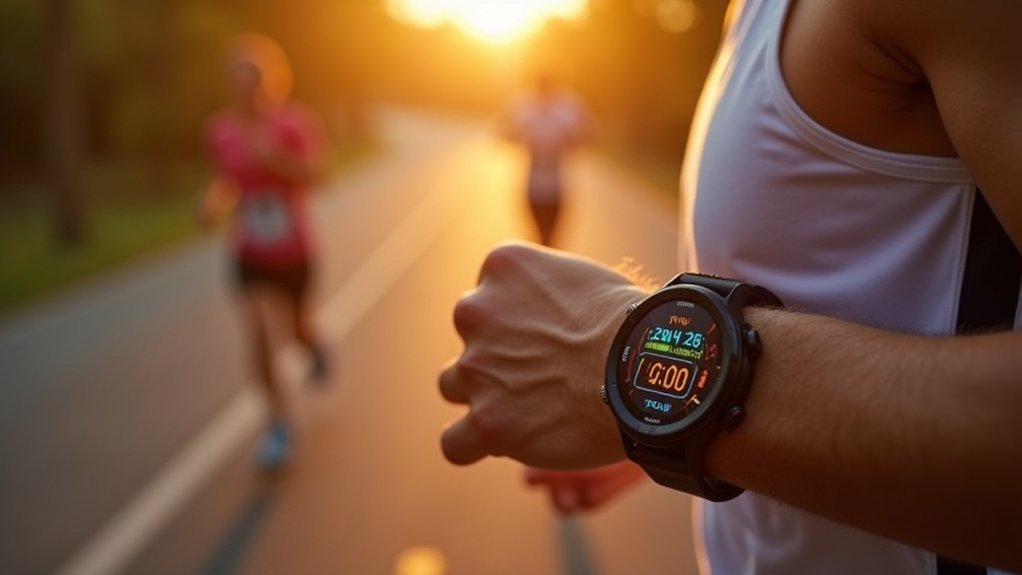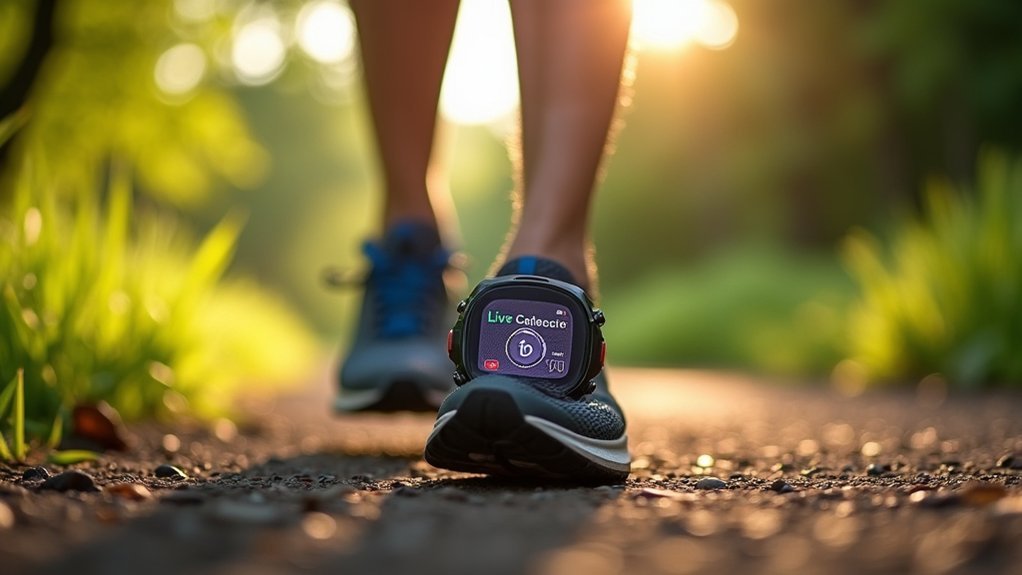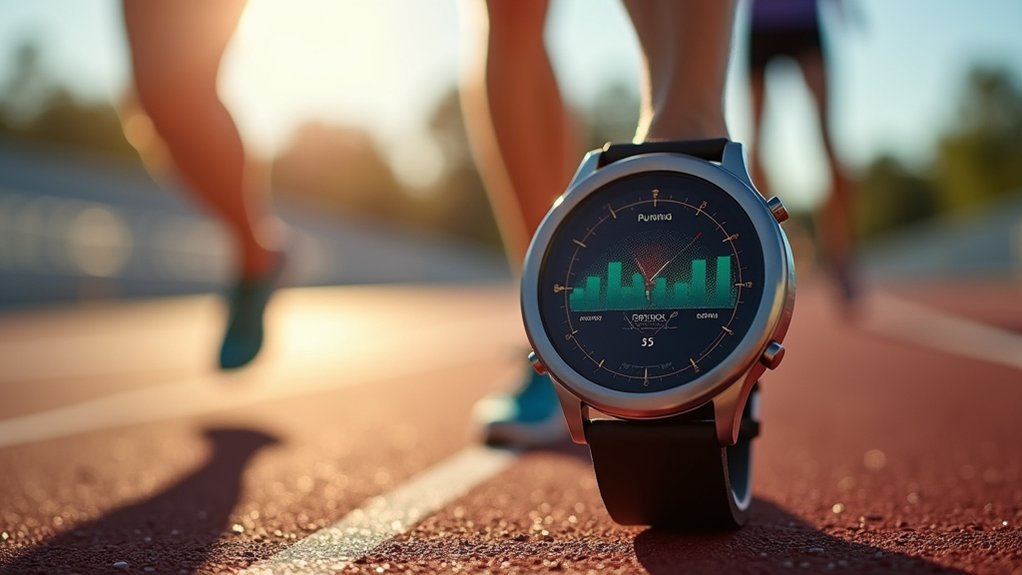Monitoring your running cadence with sport watches helps optimize your biomechanics, reducing injury risk by 5-10% through better joint alignment. You’ll receive real-time feedback to maintain the ideal 170-190 steps per minute range, allowing immediate adjustments when fatigue sets in. Sport watches accurately track your stride rate within 1-2 steps per minute, enabling you to decrease impact forces and improve running economy. The data transforms your training approach and reveals performance benefits you haven’t yet discovered.
The Biomechanical Benefits of Optimal Cadence

Running cadence—the number of steps you take per minute—serves as a cornerstone of efficient and injury-free running. When you increase your cadence, you’ll experience measurable biomechanical improvements that protect your body.
Ground contact time decreases from 0.30 to 0.27 seconds per step at higher cadences, minimizing vertical impact forces on your joints. A modest 5-10% increase in cadence can considerably reduce energy absorption at your knees and hips while decreasing overall plantar loading by 2.4-8.0%. The standard benchmark of 180 steps per minute is often cited as optimal, though this varies based on individual factors like leg length and running pace.
Increasing cadence by just 5-10% reduces joint stress and foot pressure while significantly enhancing your biomechanical efficiency.
This improved biomechanical alignment during your stride enhances hip and knee motion throughout loading phases. The result? Lower peak impact forces, better joint protection, and reduced injury risk.
Your body maintains better alignment throughout your run, creating a more efficient and sustainable running form.
Real-Time Monitoring for Injury Prevention
Your sport watch’s real-time cadence monitoring can detect potential overuse issues before they become injuries by alerting you to sudden changes in your running pattern.
By increasing your cadence through immediate feedback, you’ll reduce impact forces that typically stress your joints and bones during each footstrike. For optimal results, aim to maintain cadence in the 170 to 190 spm range, which research shows promotes better running form.
This technology transforms your watch from a simple timekeeper into an injury prevention tool that helps you make biomechanical adjustments precisely when they matter most.
Detecting Overuse Warning Signs
While most runners focus on pace and distance, your sport watch’s cadence monitoring capabilities serve as a powerful early warning system against potential injuries.
When your cadence suddenly drops during a run, it’s often the first sign of muscle fatigue or joint discomfort—precursors to more serious conditions like runner’s knee or shin splints.
Your watch can alert you to these changes immediately, allowing you to adjust your technique before damage accumulates. Low cadence increases ground contact time and impact forces, leading to over-striding that stresses joints and tissues. Higher running cadence with shorter, quicker steps can significantly decrease muscle fatigue during longer runs.
Research shows that increasing cadence by just 5% can greatly reduce injury risk. Watch for inconsistent cadence patterns, which indicate biomechanical inefficiencies that could cause problems later.
With real-time feedback, you’ll catch these warning signs before they develop into full-blown injuries.
Impact Force Reduction
When impact forces travel through your body with each footfall, they create stress that can accumulate into serious injuries over time.
By increasing your cadence even slightly, you’ll greatly decrease peak impact forces and vertical loading rates on your joints.
Your sport watch provides real-time cadence feedback, enabling immediate adjustments during runs.
As you train with higher cadence, you’ll naturally shorten your stride length and reduce overstriding—a common cause of excessive impact. This mechanical adjustment promotes more efficient muscle engagement, particularly in your glutes.
Regular monitoring through your watch helps you create customized training plans focused on maintaining ideal cadence. Studies show that a higher cadence of approximately 180 SPM is common among elite runners and can serve as a benchmark for recreational runners looking to improve.
Over time, you’ll notice reduced perceived exertion as your body adapts to this more efficient running form, while the detailed data helps you track improvements and identify potential issues before they become injuries.
How Accurate Are Sport Watches for Cadence Tracking?

Just how reliable is that cadence number on your sport watch? The truth is, it varies considerably by device and sensor type. Your watch might be off by several steps per minute without you realizing it.
| Device Type | Accuracy Concern |
|---|---|
| Wrist-based | Underestimates by 1-2 SPM, noisier data |
| Chest straps | Slight underestimation (-1.0 SPM) |
| Footpods | Most accurate, minimal bias |
| Apple Watch | “Average” cadence often 5 SPM too low |
| GPS watches | Struggles during signal loss |
For peak accuracy, consider using a footpod rather than relying solely on your watch’s internal accelerometer. If you’re making training decisions based on cadence data, remember that momentary readings can fluctuate by ±4 steps per minute due to sensor limitations and algorithmic differences between brands. Advanced biomechanical devices like RunScribe provide more comprehensive data beyond basic cadence measurements.
Balancing Training Load Through Cadence Data
Although many runners focus primarily on distance and pace, your cadence data offers a powerful tool for managing training load more effectively. By monitoring your strides per minute, you can distribute training stress more evenly across your body, potentially reducing injury risks like tendinitis and stress fractures.
Higher cadence typically reduces impact forces and eccentric muscle loading during intense workouts. Your sport watch’s real-time feedback allows immediate adjustments to enhance stride rate for different running conditions. Optimal running efficiency requires a gradual approach to reach the 180 spm benchmark that most coaches recommend.
During interval and hill training, maintaining appropriate cadence becomes essential for balancing performance gains with injury prevention.
When integrated with heart rate and blood lactate measurements, cadence data provides thorough insights into your body’s stress levels. This combined approach enables you to customize training plans based on your current efficiency, gradually progressing toward ideal running mechanics over the 6-8 week adaptation period.
Improving Running Economy With Cadence Adjustments

Running economy—your body’s energy efficiency while in motion—can be considerably enhanced through strategic cadence adjustments.
By increasing your steps per minute, you’ll naturally shorten your stride length, reducing ground contact time and oxygen consumption while lowering your heart rate.
Aim to increase your current cadence by 5-10%, working toward the efficient benchmark of 180 steps per minute.
Incorporate short intervals where you focus on quicker toe-offs and arm swings, gradually adapting to the new rhythm. Your sport watch provides invaluable real-time feedback to guide these adjustments. Higher cadence promotes landing directly under your center of gravity, significantly improving energy efficiency.
The benefits are substantial: improved performance without increased energy expenditure, potentially reduced injury risk, and enhanced endurance.
Remember that ideal cadence varies based on your height and biomechanics, so use your watch data to find your personal sweet spot.
Using Wearable Feedback to Perfect Your Running Form
Modern sport watches transform your running experience by delivering precise, real-time feedback on critical form elements while you’re in motion.
These devices provide immediate data on cadence, speed, and stride length, enabling you to make instant adjustments that reduce injury risk and enhance performance.
When your watch alerts you to overstriding or suboptimal cadence, you can correct your technique on the spot rather than developing problematic habits.
This immediate feedback loop improves your biomechanical awareness and helps you run more efficiently.
The user-friendly interfaces make interpreting data simple, even during intense workouts.
By consistently applying these real-time insights, you’ll develop sustainable running habits with reduced injury risk and improved race results.
Your wearable becomes a personal coach that empowers proactive improvement with every step.
Personalizing feedback according to your individual motives for running can significantly enhance motivation and adherence to training programs.
Frequently Asked Questions
How Does Weather Affect Optimal Running Cadence?
Weather considerably affects your ideal running cadence—heat and humidity slow it down as your body manages thermal stress, cold temperatures may decrease efficiency, and wind/solar radiation require adjustments to maintain comfortable exertion levels.
Can Cadence Analysis Benefit Ultra-Marathon Runners Differently Than Sprinters?
Yes, cadence analysis benefits you differently: as an ultra-runner, you’ll focus on sustainable rhythm to prevent fatigue and injuries over long distances, while as a sprinter, you’ll use it to maximize power and explosive speed.
Do Different Running Surfaces Require Adjustments to Target Cadence?
Yes, you’ll need to adjust your cadence for different surfaces. Increase it on soft or uneven terrain for stability, while hard surfaces may allow slightly lower cadence. Monitor these changes with your sport watch.
How Does Aging Impact Ideal Cadence Measurements?
As you age, your ideal cadence typically remains stable or increases slightly to compensate for shorter stride length. You’ll benefit from maintaining higher step rates to reduce impact forces and protect aging joints while running.
Should Runners Maintain Consistent Cadence During Hill Training?
Yes, you should maintain consistent cadence during hill training. It improves running economy, prevents injuries, preserves muscle engagement patterns, and enhances overall performance by promoting efficient foot strike and reducing ground contact time.
In Summary
Tracking your cadence with a sport watch gives you immediate access to one of running’s most vital metrics. You’ll prevent injuries, improve efficiency, and perfect your form with data-driven feedback. While no device is perfect, today’s watches offer reliable cadence monitoring that helps you balance training loads effectively. By making small adjustments to your step frequency, you’re investing in both performance and longevity as a runner.





Leave a Reply